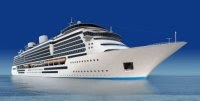The cost-effective and safe transportation of people and goods is vital to our economy. As modern modes of transport have evolved to meet increasing demands for safety, environmental protection and speed, the use of plastics in transport manufacture has risen dramatically. In 1998, around 390 ktonnes of plastics were used in transport applications in the UK.
All forms of transport require energy to run and fuel represents a substantial part of running costs. Cutting the weight of cars, aeroplanes, boats and trains can cut fuel consumption dramatically. The lightness of plastics therefore makes them invaluable to the transport industry. 105kg of plastics, rather than metals, in a car weighing 1,000kg makes possible a fuel saving of up to 7.5%.
Used externally plastics are durable, do not corrode and require little maintenance. They allow freedom of design and fast and economical manufacture. Internally, plastics fittings, such as dashboards, flooring, seats and faces, maintain their attractive appearance and are easy to clean.
|
Automotive
 More plastics, by volume, than steel are now used in today’s cars for a myriad of components. At the end of a vehicle’s working life, plastics components can be recycled or the energy can be recovered through incineration Plastics versatility aids the automotive industry in meeting ever more stringent requirements in terms of economical performance, safety, comfort and environmental considerations More plastics, by volume, than steel are now used in today’s cars for a myriad of components. At the end of a vehicle’s working life, plastics components can be recycled or the energy can be recovered through incineration Plastics versatility aids the automotive industry in meeting ever more stringent requirements in terms of economical performance, safety, comfort and environmental considerations
Plastics also play a key role in providing cost effective buses and trucks for transporting people and goods efficiently. |
|
|
Aerospace
 The aerodynamic requirements of aerospace products demand maximum design flexibility and minimal weight. Plastics can be formulated to meet a wide variety of specifications and are ideal for components incorporating smooth curves. Composites are widely used in the panels of military jets and helicopters as well as for wing skins, nacelles, fairings, flaps and helicopter rotor-blades in commercial applications. Plastics are also found throughout aircraft interiors in, for example, bulkheads, galleys, stair units, seating and flooring. The aerodynamic requirements of aerospace products demand maximum design flexibility and minimal weight. Plastics can be formulated to meet a wide variety of specifications and are ideal for components incorporating smooth curves. Composites are widely used in the panels of military jets and helicopters as well as for wing skins, nacelles, fairings, flaps and helicopter rotor-blades in commercial applications. Plastics are also found throughout aircraft interiors in, for example, bulkheads, galleys, stair units, seating and flooring.
|
|
|
Rail
 Materials used in railway locomotives, carriages and other rolling stock have to withstand wear and tear from heavy use. The durability of plastics is one of the factors making them the first choice for engine and carriage panels, flooring, luggage racks, seating and doors. Materials used in railway locomotives, carriages and other rolling stock have to withstand wear and tear from heavy use. The durability of plastics is one of the factors making them the first choice for engine and carriage panels, flooring, luggage racks, seating and doors.
|
|
|
Marine
 Plastics’ ability to withstand a harsh marine environment makes them essential in all types of marine craft, from ocean liners to sailing dinghies. Plastics do not corrode or warp and need less maintenance than other traditional materials to remain attractive and in good working condition. Plastics’ ability to withstand a harsh marine environment makes them essential in all types of marine craft, from ocean liners to sailing dinghies. Plastics do not corrode or warp and need less maintenance than other traditional materials to remain attractive and in good working condition.
|





